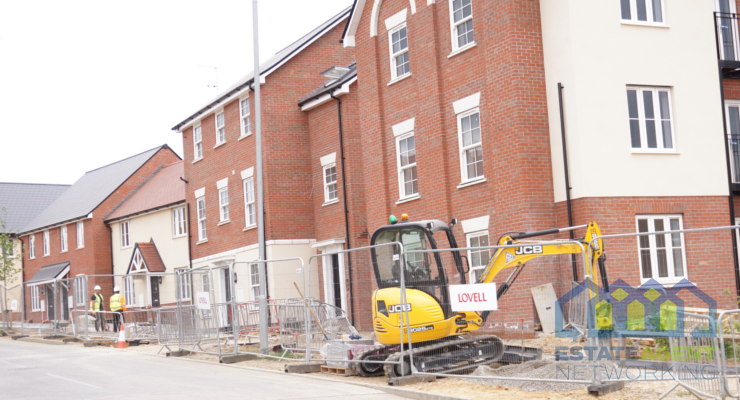Rents hit new record & city tenants down-size to studio flats
- National average asking rents outside London have hit a new record, now £1,162 per calendar month (pcm):
- Asking rents jump by more than 3% this quarter (+3.2%) for only the third time on record
- Average London rents rise to £2,343 pcm, leading to the biggest ever annual jump of 16.1%
- More new rental properties are available in every region except London, easing some of the pressure on supply in some areas, however demand still greatly outweighs the number of homes available to rent:
- Tenant demand is up 20% compared with last year, and available properties to rent is down 9%
- Competition among tenants to secure a property is at a record high
- Jump in mortgage rates for new first-time buyers could mean some aspiring buyers stay renting for longer, which will place further strain on the number of available homes
- Studio flats have overtaken one-beds as the most in-demand flat type for renters, with agents suggesting stretched budgets and the returning popularity of city centres are contributing to the shift:
- There are now four times as many tenants looking for a studio flat as there are studio flats available, a 71% increase on a year ago
Average asking rents for new tenants outside of London have risen to a new record of £1,162 per calendar month. This quarter’s increase of 3.2% is only the third time on record that rents have increased by 3% or more in a quarter, as new asking rents continue to rise rapidly.
In London, average asking rents rise to a record of £2,343 pcm this quarter. This puts the annual rate of asking rent growth in the capital at 16.1%, the highest yearly rate of growth of any region on record.
The pace of asking rent growth is primarily down to the severe shortage of available rental properties, combined with extremely high demand which continues to surpass even last year’s levels in every region and country of Great Britain.
Demand is up by 20% compared with last year, while the total number of available properties to rent is down by 9%. This widening gap between supply and demand is creating ever fiercer competition between tenants looking for a home.
In London, the number of new properties becoming available to rent is down by 24% on last year, while every other region and country in Great Britain has seen a jump in new properties to rent, most significantly in the South West (+19%), Yorkshire & The Humber (+12%) and Wales (+10%).
There is some way to go to narrow the gap between supply and demand enough to steady new asking rents, however it does at least give tenants in many areas some more choice compared with last year, though they are very likely to still be competing for the property with many other renters.
Recent mortgage interest rate rises means that even with record rents, the average monthly mortgage payment for a new first-time buyer putting down a 10% deposit is now a fifth (20%) more than the rental payment for the equivalent type of property – £1,121 pcm for the mortgage payment compared with £932 pcm to rent.
A knock-on effect of the rise in mortgage interest rates could be that some first-time buyers who can no longer afford the property they wanted, or have decided to wait to try and get a clearer view of the market, may decide to extend their tenancy.
This would place added pressure on the demand for flats and smaller properties to rent, at a time when demand for smaller properties to rent is already especially high. Studio flats have overtaken one-beds as the most in-demand type of flat for renters.
Studio flats were typically more in demand in the years leading up to the pandemic, however they were overtaken by one-beds when the market reopened in May 2020 and city living temporarily became less popular.
Competition between tenants for available studios is 71% higher than it was last year and there are now four times as many tenants looking for a studio flat as there are studio flats available.
Agents suggest that stretched budgets and the returning popularity of city centres are contributing to the shift, as more tenants look for the cheapest property available without giving up the city centre location, instead of potentially getting more for their rent further out.
Rightmove’s Director of Property Science Tim Bannister said: “It’s a real challenge for renters at the moment, as there are simply not enough homes available to rent to meet the demand from people enquiring. Whilst it’s positive news that most areas are seeing more properties coming to market, with London the notable exception, ultimately the gap between supply and demand is becoming wider across the board. We will need a significant addition of homes to come onto the market to even begin to balance the scales. Those looking to rent a smaller property in the next few months may find that they face some added competition from would-be first-time buyers, who have had their purchase plans scuppered for now due to the sudden rise in mortgage interest rates, and are now looking to rent.”
Agents’ Views
John O’Malley, CEO at Pacitti Jones in Glasgow, said: “The desire to return to the city centre has never been more apparent and the exceptionally high demand we now experience for properties in these locations is case in point. In essence younger professionals want the same things as they always wanted – to go out and have a good time – and this means being back in the heart of our cities and enjoying the social amenities available.
“It’s not just the younger generation looking to live in vibrant city centre locations. The dramatic rise in the cost of living means that we are now starting to see older people downsizing to apartments to reduce household bills – and being centrally located they will also reduce travel expenses. And this is something we expect to see more of.”
Tim Hassell, Director at Draker Lettings in London said: “As the summer market comes to an end, we have seen a significant increase in the number of tenants competing for a new property as soon as it comes to the market.
“Within a few hours of a property going live, we are receiving dozens of enquiries which, when compared to the pre Covid market, is extreme. Previously we would receive between 5-10 enquiries in the first 48 hours and now we are receiving 30-40 in the same time frame. This has also resulted in multiple offers from tenants who are competing by paying over the asking price and offering significant funds up front.”









